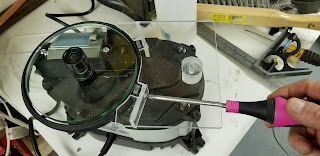Accessorizing the WS 3000
I recently bought a Worksharp WS3000. I was thinking about how to build one but the price on Amazon suggested it probably wasn't worth the hassle and my time away from my other projects.
That said, I found the accessories to be pretty expensive and the tool bar attachment is no longer available.
Diamond Lapping Plates
DMT sells a sharpening and honing kit for the WS3000. The kits use a 6" diameter lapping plate. The lapping plate is held onto the glass disk with a sticky back magnetic sheet (like a refrigerator magnet. These are pricey, on amazon for $65 + shipping.
I started to covet this accessory but then found that McCauley had already figured out a replacement using stock Amazon parts.
These parts are on order to try this system out...
3000 grit Diamond coated sheets (don't waste your money on this)
About $40 total. I will report back after testing this system
I used the above setup to sharpen a plane's blade. All of the disks worked perfectly except the 3000 grit. It immediately scored the disk and the planes cutting edge.
I have found an alternative 3000 grit lapping plate that albeit more expensive it got better reviews. It is included in the parts kit I created.
I also found that the magnet sheet is not really necessary. Putting the lapping plate on the spindle first and then the glass plate on top works fine.
I ended up using the magnet sheet to hold the lapping plates on the wall near my sharpening station :)!
Worksharp-3000-lapping-upgrade Kit
I used the above setup to sharpen a plane's blade. All of the disks worked perfectly except the 3000 grit. It immediately scored the disk and the planes cutting edge.
I have found an alternative 3000 grit lapping plate that albeit more expensive it got better reviews. It is included in the parts kit I created.
I also found that the magnet sheet is not really necessary. Putting the lapping plate on the spindle first and then the glass plate on top works fine.
I ended up using the magnet sheet to hold the lapping plates on the wall near my sharpening station :)!
Lapping Disk Kit
I built this kit of parts for this build. If you use this kit to buy your parts I make some affiliate $ and it costs you nothing.Worksharp-3000-lapping-upgrade Kit
Other WS3000 Accessories
I also made these accessories:
Additional Disks
Tool Bar Attachment [I will make this if I have trouble sharpening my carving gauges]
If you enjoyed this project/post or my blog consider donating which funds more tool and materials.
You can donate by clicking the "DONATE" button in the upper right of this site.
Don































